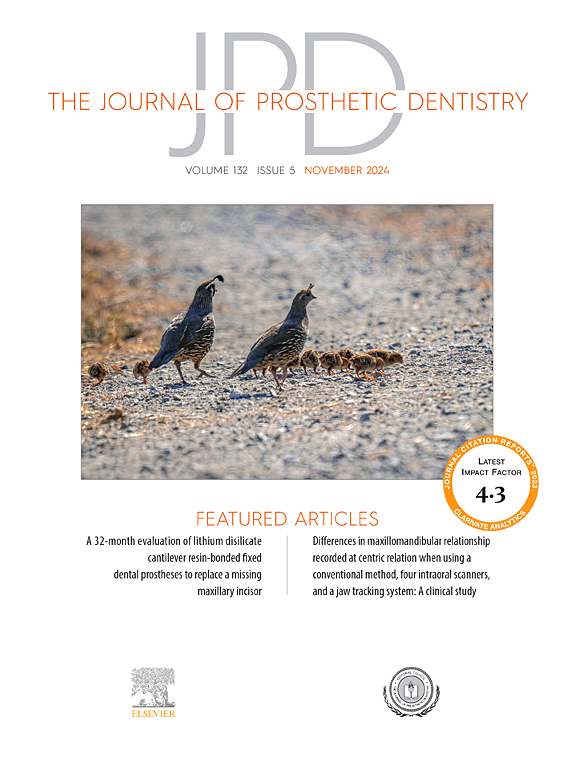Fracture resistance, 3-dimensional finite element analysis, and safety factors for five post-and-core restorations with crowns placed in the noncircular-shaped canals of premolars
IF 4.3
2区 医学
Q1 DENTISTRY, ORAL SURGERY & MEDICINE
引用次数: 0
Abstract
Statement of problem
Restoring endodontically treated premolars with noncircular canals presents a significant challenge.
Purpose
The purpose of this study was to compare the in vitro fracture resistance and the finite element computational calculation-based stress and safety factor of noncircular-shaped, endodontically treated premolars restored with 5 different prefabricated and custom computer-aided design and computer-aided manufactured post-and-core systems.
Material and methods
Fifty single-rooted oval-shaped canal maxillary premolars were endodontically treated and post spaces were prepared. The specimens were divided into 5 categories on the basis of the post-and-core system used: Group CN composite resin core without a post, Group CF prefabricated fiber-reinforced composite resin post and composite resin core, Group IC interpenetrating phase composite post-and-core, Group LS lithium disilicate post-and-core, and Group ZR zirconia post-and-core. Lithium disilicate crowns were fabricated and cemented on the 5 different post-and-core systems and subjected to a fracture resistance test using a spherical indenter with static loading. Differences in fracture resistance were evaluated using a 1-way analysis of variance (ANOVA) (α=.05). The 3-dimensional finite element method was used to determine the von Mises stress and safety factors, defined as the ratio of the material's strength to the von Mises stress experienced, within different compartments of the restored tooth model.
Results
In the in vitro fracture resistance test, the mean ±standard deviation fracture loads of the 5 groups were 2144 ±515 N, 1801 ±600 N, 1690 ±312 N, 1612 ±545 N, and 1487 ±600 N, respectively and were statistically similar (P=.078). All specimens within the ZR group exhibited restorable fractures. In contrast, only 30% of the CN group specimens showed restorable fractures. The incidence of restorable fractures in the CF, IC, and LS groups was 70%, 80%, and 70%, respectively. Although all groups showed similar maximum von Mises stress and stress distribution, safety factors in the models varied significantly. The ceramic crown was the weakest component in the LS and ZR groups, with much lower safety factors than dentin and post-and-core regions. Additionally, the CN group's wider dentin area had a demonstrably lower safety factor.
Conclusions
Endodontically treated noncircular-shaped canal premolars showed minimal effect on fracture resistance regardless of post type. However, for teeth with sufficient ferrule, using any post-and-core system significantly reduced the incidence of nonrestorable fractures compared with just a coronal foundation restoration, with custom zirconia offering the potential of achieving a restorable outcome after fracture.
前磨牙非圆形根管内冠桩核修复体的抗折性、三维有限元分析及安全系数。
问题陈述:用根管治疗的非圆管前磨牙的修复是一个重大的挑战。目的:比较5种不同的预制和定制计算机辅助设计及计算机辅助制造桩核系统修复的非圆形、经根管治疗的前磨牙的体外抗骨折性及有限元计算的应力和安全系数。材料与方法:对50颗单根椭圆形管状上颌前磨牙进行根管治疗,并准备后位。根据柱核体系的不同,将试样分为5类:CN组复合树脂芯不带桩、CF组预制纤维增强复合树脂桩和复合树脂芯、IC组互穿相复合桩核、LS组二硅酸锂桩核、ZR组氧化锆桩核。制作二硅酸锂冠并将其粘合在5种不同的桩芯系统上,并使用静态负载的球形压头进行抗断裂测试。采用单因素方差分析(ANOVA)评估抗骨折性差异(α= 0.05)。采用三维有限元法确定修复牙模型不同隔室内的von Mises应力和安全系数(定义为材料强度与所经历的von Mises应力之比)。结果:在体外抗骨折试验中,5组小鼠骨折载荷的平均值±标准差分别为2144±515 N、1801±600 N、1690±312 N、1612±545 N、1487±600 N,差异有统计学意义(P= 0.078)。ZR组所有标本均表现为可恢复性骨折。相比之下,CN组只有30%的标本显示可恢复骨折。CF组、IC组和LS组的可恢复性骨折发生率分别为70%、80%和70%。虽然各组的最大von Mises应力和应力分布相似,但各模型的安全系数差异显著。在LS组和ZR组中,陶瓷冠是最弱的部件,其安全系数远低于牙本质和桩核区域。此外,CN组牙本质面积较宽,其安全系数明显较低。结论:采用根管治疗的非圆形根管前磨牙,无论柱型如何,对其抗骨折性的影响都很小。然而,对于有足够卡箍的牙齿,使用任何桩核系统与冠状基础修复相比,显著降低了不可恢复性骨折的发生率,定制的氧化锆提供了骨折后实现可恢复性结果的潜力。
本文章由计算机程序翻译,如有差异,请以英文原文为准。
求助全文
约1分钟内获得全文
求助全文
来源期刊

Journal of Prosthetic Dentistry
医学-牙科与口腔外科
CiteScore
7.00
自引率
13.00%
发文量
599
审稿时长
69 days
期刊介绍:
The Journal of Prosthetic Dentistry is the leading professional journal devoted exclusively to prosthetic and restorative dentistry. The Journal is the official publication for 24 leading U.S. international prosthodontic organizations. The monthly publication features timely, original peer-reviewed articles on the newest techniques, dental materials, and research findings. The Journal serves prosthodontists and dentists in advanced practice, and features color photos that illustrate many step-by-step procedures. The Journal of Prosthetic Dentistry is included in Index Medicus and CINAHL.
 求助内容:
求助内容: 应助结果提醒方式:
应助结果提醒方式:


